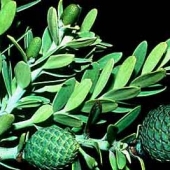Please select root levels for the menu
NZ Plants
Halocarpus kirkii - Kirk’s pine
Podocarp family: Podocarpaceae
-
Mature foliage
I MacDonald
View picture -
Mature foliage
L Jensen
View picture -
Mature foliage, leaves with obscure keel
L Jensen
View picture -
Juvenile foliage
I MacDonald
View picture -
Juvenile branch giving rise to a branch with mature foliage
L Jensen
View picture -
Bark
L Jensen
View picture -
Seed cone
J Braggins
View picture
Halocarpus kirkii is a tree with an attractive tapering form. Juvenile plants have large linear leaves which pass abruptly into the overlapping scale-like leaves of the adult. Small fleshy ovule cones are formed in which the ovule is inverted and covered with both an integument and an outer epimatium (derived from the seed scale). After fertilisation, the epimatium at the base of the seed expands and becomes fleshy. Formerly known as Dacrydiuim kirkii
An endemic species found in localised populations on the central North Island.
Named after the English-born botanist, Thomas Kirk, who settled in New Zealand and made extensive collections.
Vegetative characteristics |
Reproductive characteristics |
|---|---|
Adult plant form: tree up to 25 m |
Pollen and ovule cones: on separate trees |
Adult leaf form: scale-like with obscure ridge (keel) on lower (outer) surface |
Pollen cone: terminal on stems, up to 1 cm long |
Adult leaf size: 2-3 mm |
Ovule cone: 1-3 fertile cone scales and 1-3 sterile bracts |
Adult leaf arrangement: spiral, flattened (appressed) to the stem |
Ovule position: on upper surface of cone scale |
Juvenile leaf form: linear, stiff but not prickly |
Ovule coverings: an inner covering (integument); a black outer epimatium |
Juvenile leaf size: 15-40 mm |
Ovule pore (micropyle): directed downward |
Juvenile leaf arrangement: spiral, spreading away from the stem |
Mature seed cone: 1-3 ribbed black seeds with an orange, fleshy basal outgrowth of the epimatium |
Stem (receptacle) below seed: 1-3 bracts below the seed remain similar to the scale leaves |




